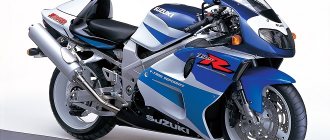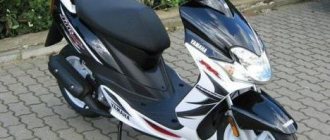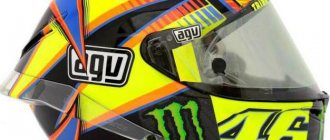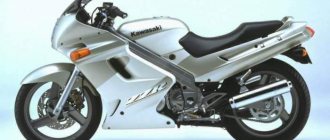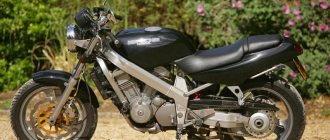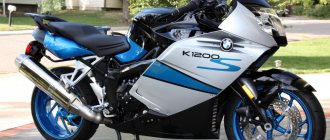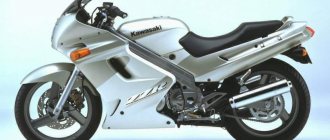RU-MOTO rating
- Reliability
- Chassis
- Appearance
- Comfort
4.3
Verdict
It’s definitely nice that in the history of motorcycle production there are such bright examples as the Yamaha V-max. The motorcycle is far from ideal in terms of technology and does not fit into many standards. But this is precisely what has driven it into motorcycle history forever, so firmly that years later its popularity remains at its highest, and true connoisseurs are willing to give a lot to have such a beast in their garage.
This is not even a wolf in sheep's clothing, but a real devil. This is how you can begin to characterize the motorcycle that we will discuss today in our review. Yamaha V-max 1200 is one of the most controversial and template-breaking motorcycles of its time.
Motorcycle Yamaha V-max 1200
The legend appeared back in 1985 and existed without significant changes until 2007. The motorcycle had nothing in common with copies on the market. Received a powerful motor of a Yamaha XVZ 1200 Venture touring motorcycle, built into the cruiser frame.
Like a black sheep, the motorcycle attracted attention for a long time, already in the first years it received several titles according to various communities and amassed a strong army of fans. So, after a long time, we could not pass by.
Specifications
As we have already mentioned, the V-shaped four-cylinder engine migrated to us from the Yamaha XVZ 1200 Venture touring motorcycle. It had four valves per cylinder and was equipped with a liquid cooling system.
Read other motorcycle reviews of Lifan LF 200 - is it worth buying?
Previously, the site Ru-moto.com published a review of the Yamaha YZF-R6 motorcycle
In many ways, the engine was interesting due to the presence of four cylinders in a V-shaped arrangement, instead of the usual two. But the main feature was the V-Boost system, the installation of which resulted in an increase in engine power characteristics to 35-40% of the stock state. The essence of the V-Boost system is to open additional throttle valves between the first and third, second and fourth intake manifold. The system comes into operation when the engine reaches 6000 rpm. In various modifications, it was possible to extract from 98 to 145 horsepower and from 100 to 124 Nm of torque from the engine. At the time the motorcycle was released, these figures were among the highest, even for the class of sports models, despite the fact that the Yamaha V-max was a cruiser. The most desirable modification for connoisseurs was the modification produced for California with a 145 hp engine.
The gearbox is 5-speed, and the entire herd of horses is connected to the wheel via a driveshaft.
Technical characteristics of Yamaha XVZ 1200 Venture
As for the suspension, we have: in front there is a telescopic fork with no adjustments, the travel of which is 140 mm, in the rear there is a classic pendulum and two shock absorbers with a travel of 85 mm. The motorcycle can be called comfortable, but years of operation have revealed that the suspension is unsafe at such power levels - it is too soft.
To stop such a powerful and, moreover, very difficult horse, brakes are installed: at the front there are two discs with a diameter of 282 mm, at the rear there is one disc of the same diameter. But this turned out to be not quite enough; users would like to see a more effective braking system.
As a result, we get: a motorcycle with a cruiser design, a huge touring engine with a power of 145 hp, a significant weight of 284 kg, and a fairly soft suspension. Moreover, this whole thing is capable of accelerating to 250 km/h. Isn't this real devilry?
Engine
| Number of cycles | 4 |
| Number of cylinders | 4 |
| Number of valves per cylinder | 4 |
| Configuration | V-shaped |
| Working volume | 1679 cm³ |
| Bore and stroke | 90×66 mm |
| Maximum power | 200 hp at 9000 rpm |
| Maximum torque | 166.8 N•m at 6500 rpm |
| Intake type | Injector |
| Recommended fuel | AI-95 |
| Cooling system | Liquid |
| Starting system | Electric starter |
Transmission
Read other motorcycle reviews Full review of the Kawasaki Ninja 300 motorcycle
| Gearbox type | Mechanical |
| Number of gears | 5 |
| Clutch | Multi-disc, oil bath |
| main gear | Cardan |
Dimensions and weight
| Length | 2395 mm |
| Width | 820 mm |
| Height | 1190 mm |
| Seat height | 775 mm |
| Wheelbase | 1700 mm |
| Ground clearance | 140 mm |
| Curb weight | 310 kg |
| Fuel tank capacity | 15 l |
Chassis and brakes
| Frame | Aluminum diagonal |
| Suspension | |
| Front | Telescopic fork |
| Front suspension travel | 120 mm |
| Rear | Pendulum with monoshock absorber |
| Rear suspension travel | 110 mm |
| Brakes | |
| Ahead | Double disc hydraulic |
| Diameter | 320 mm |
| Behind | Disc hydraulic |
| Diameter | 298 mm |
| Tires | |
| Ahead | 120/70 R18 59V |
| Behind | 200/50 R18 76V |
Performance characteristics
| Maximum speed | 220 km/h |
| Acceleration time 0 - 100 km/h | 2.7 s |
Options for purchasing a motorcycle
Those who want to purchase a high-quality motorcycle with excellent technical characteristics can, of course, try to do it themselves. But why take the risk if it’s better to entrust it to specialists. The Cemeco.ru company takes a very responsible approach to cooperation with foreign partners and always acts in the interests of the client. On the pages of the company’s website you can familiarize yourself with the entire range of motorbikes offered, as well as study the important characteristics of the motorcycle you like. Our consultants will definitely contact the customer and clarify all the details regarding the design of the selected bike, brand, year of manufacture and other details. The company's employees are highly qualified and have extensive experience in the global motorcycle market. We are ready to provide our clients with the following services: • help choose a model; • complete documents correctly; • resolve customs issues; • ensure timely delivery of the motorbike to the client, and resolve many other issues. Our company guarantees the quality of the imported motorcycles and short delivery times from Japan. Another important factor in favor of cooperation with us is the minimal cost of the services and goods provided, unlike other companies. Choose professionals to purchase powerful transport.
Repair and service
Wild power has its side effects. Yamaha V-max is the motorcycle whose engine could not be curbed. Excess power constantly tests the strength of the components and assemblies of the motorcycle.
Maintainability of Yamaha V-max 1200
The first thing to hit is the clutch; if you disassemble almost any used motorcycle, we will see serious signs of wear and overheating. Problems with the gearbox are mainly associated with the second gear, which often fails if engaged incorrectly.
When driving aggressively, the cardan also cannot withstand. The frame tends to burst and become deformed. The plastic star of the oil pump can also be called a serious flaw; if it fails, oil starvation occurs and, as a consequence, the inevitable death of the engine.
The large community of owners of this model saves the day; almost all of the problems described above have been solved, many of them can be predicted and treated in advance. Motorcycle maintenance has no special features as such.
Price
Terms like “most powerful,” “most beautiful,” and “coolest” come at a price. If you try, even today you can find a new Yamaha 1200 V-max motorcycle from the officials. Its cost, depending on the year of manufacture, will be 15-20 thousand dollars. There are 6-7 thousand copies on the secondary market, but their technical condition and degree of wear raise questions. On average, you can buy a device for $10,000-13,000.
Price
New Yamaha V-max 1200 are no longer produced, so our market consists entirely of used models. Prices for these options vary greatly, depending on the condition. For a good version from more recent years, they can easily ask for $10,000-12,000. An important criterion affecting the price is the modification (depending on the country of delivery), the Californian version will be the most desirable.
Screenshot 1. Price for used Yamaha V-max 1200 on Avito
Owner reviews
Belokonov Konstantin (KOT)
Hello. In my opinion, there are two types of motorcycles for showing off and riding. Although the design of 1985 is noticeably behind modern ones, the V-MAX is not of the time. And it is for Riding. I think I have the right to say this because I have owned it since 2008. I’ve been a fan of motorcycling since 1987, and during this time I’ve driven everything from the domestic motorcycle industry to the Gold Wing. The true soul and heart of the engine is revealed on good country roads. It’s hard to describe in words, you have to feel it. It’s not for nothing that they write songs about MAX… Having bought this Mot, it’s impossible not to fall in love with it or hate a third. All my comrades who switched to V-MAX have never regretted it. And don’t believe anyone until you feel it yourself. I’d like to make a reservation right away. The Mot is only for guys who have a good experience in driving heavy vehicles and driving experience. In technical terms, my copy has only changed consumables for 7 years: Oil, pads, filters. The rear eats rubber quite well, 9-10 thousand before 15-17 thousand after all, the weight Now I installed the most expensive Meseller Marathon, let's try. I don’t recommend it for long-distance travelers, although I myself traveled to St. Petersburg with my wife and luggage without problems. Even if something breaks, everything is available and at low prices compared to modern counterparts. Well, something like this... Belokonov Konstantin
Pablo escobar
I want to share my opinion about another prominent representative in the world of motorcycles. This is a first generation Yamaha V-MAX 1200 motorcycle. This is a road worker, but in fact there is still no definitive definition for it. Many people consider it a chopper because it has a low stance, while others consider it a drag racing motorcycle because of its power. In general, there is no consensus, and this is not so important, in fact. A little about the filling of this beauty. Engine: V-shaped engine, volume 1200 cc. cm, 140 horsepower, liquid cooling, 4-piston, 4 valves per piston. Moreover, at low speeds only two valves per piston operate. I'll tell you in more detail below. In general, in my opinion, Yamaha designers have created an amazing motorcycle. Combined power and beauty into one whole. For a beginner who does not know this motorcycle, it will be an obvious mystery. The whole appearance of the V-MAX is so deceptive that many are simply lost. Let’s say the V-MAX’s fuel tank is not actually one, it’s there as if for beauty, but the real one is under the seat. The same goes for the huge air intakes on the sides. They are also only for beauty, since the engine is liquid cooled, but what brutality they give to this motorcycle! The V-MAX is not that difficult to drive, although it weighs about 300 kg, but due to its low center of gravity it is not difficult to hold. It steers easily. The acceleration is simply crazy, it can easily give odds to a sportbike. When the tachometer needle reaches 6700 rpm, the V-MAX turns on the so-called V-BOOST system, which connects a second pair of valves to each piston and the motorcycle gets a “second wind”. The engine simply explodes and a herd of 140 horses takes you far from your pursuers. The only negative about this motorcycle is the small volume of the fuel tank - only 15 liters. With such engine power, it lasts for 160 kilometers, but what unforgettable kilometers these will be! Filled with wild power, speed and a feeling of complete freedom!Pablo escobar
Irbis455
Like many other owners, I can’t decide which class this bike belongs to. My opinion is that this is still a chopper. Its engine is almost like a car's. The similarity is not only in volume but also in the high torque, especially at low speeds. It starts quite easily from second gear. The bike weighs almost three hundred kilograms and takes turns with ease. The suspension is quite soft, the motorcycle is not designed for Russian roads; it is better to avoid potholes, and if you hit them at high speed, there is a high probability of falling; in this case, it is better to jump off so that the bike flies forward, otherwise serious injuries cannot be avoided. It does not have a reverse gear, which causes some inconvenience when parking. Irbis455
Production history overview
In 1985, the premiere and start of serial production of the Yamaha 1200 V-max took place. The model was produced in its original form until 1993. And the changes made this year were not so significant. The fork diameter was increased to reduce wobbling at high speeds, and the braking system was updated. The changes mainly concerned improving the characteristics of the motorcycle, increasing its safety and controllability. Since then, the model was produced until 2007, until it was officially discontinued. It was replaced by the no less legendary and popularly loved Yamaha VMAX 1700.
It’s worth mentioning the model’s main competitor, the Honda CB1300DC. It was designed as a response to Yamaha, but the concept was a failure. Interesting in design and quite decent in terms of technical equipment, the Honda could not outshine the Yamaha 1200 V-max. Although she still acquired a certain number of ardent fans. This model was produced for only 4 years, from 1997 to 2001.
Tuning
First of all, tuning such a motorcycle is aimed at eliminating chronic diseases. Owners order special arches for their motorcycles, which increase the rigidity and strength of the frame. The extremely small original tank is enlarged by welding to 15 liters. They also get to the oil pump star, successfully changing it from plastic to metal. More extensive work is being carried out on the engine. Crazy masters manage to turbocharge a Yamaha, producing a real drag monster.
Read other motorcycle reviews Detailed review of the KTM Duke 390 motorcycle
Yamaha XVZ 1200 Venture tuning options
By searching the Internet, you can easily find entire tuning kits for this motorcycle, made by someone with their own hands, with all the diagrams and spare parts. An example is the modification of the pendulum to accommodate a wide wheel. Or installing an alternative plug.
Modifications
Various modifications of the Yamaha V-max 1200 motorcycle were supplied to markets in different countries and at different times.
| Engine model | Year of issue | Country of delivery | Power | Torque | Changes |
| 1FK | 1985 | USA | 145 hp | 124 Nm | 35 mm carburetor, V-boost, speedometer in miles |
| 1JH | 1985 | USA | 145 hp | 124 Nm | Emission control, changes in carburetor and camshaft operation |
| 1GR | 1985-1986 | Canada | 145 hp | 124 Nm | 35 mm carburetor, V-boost, speedometer in km/h |
| 1UT | 1986 | USA | 145 hp | 124 Nm | minor changes compared to 1FK |
| 1UR | 1986 | USA | 143 hp | 120 Nm | minor changes compared to 1JH |
| 2EN | 1987-1990 | Europe | 122 hp | 102 Nm | 35 mm carburetor, no V-boost, speedometer in km/h, light switch, changed final drive |
| 2WE | 1987-1990 | USA | 145 hp | 124 Nm | 35 mm carburetor, minor changes compared to 1UT |
| 2WF | 1987-1990 | USA | 140 hp | 120 Nm | 35 mm carburetor, minor changes compared to 1JH |
| 2LT | 1987-1992 | Canada | 145 hp | 124 Nm | 35 mm carburetor, minor changes compared to 1GR, ignition changed |
| 2WE | 1991-1992 | USA | 140 hp | 120 Nm | changes in the operation of camshafts, ignition system, exhaust system |
| 2WF | 1991-1992 | USA | 136 hp | 118 Nm | changes in the operation of camshafts, ignition system, exhaust system |
| 2EN | 1991-1992 | Europe | 120 hp | 100 Nm | changes to the fork and brake system |
| 2WE | 1993-1995 | USA | 140 hp | 120 Nm | changes to the fork and brake system |
| 2WF | 1993-1995 | USA | 136 hp | 118 Nm | changes to the fork and brake system |
| 2LT | 1993-1995 | Canada | 140 hp | 120 Nm | changes to the fork, brake system, exhaust |
| 2EN | 1993-1995 | Europe | 120 hp | 100 Nm | changes to the fork and brake system |
| 2WE | 1996-2001 | USA | 136 hp | 118 Nm | changes in the oil filter, gearbox, gearbox, clutch |
| 2WF | 1996-2001 | USA | 136 hp | 118 Nm | changes in the oil filter, gearbox, gearbox, clutch |
| 2LT | 1996-2001 | Canada | 140 hp | 120 Nm | changes in the oil filter, gearbox, gearbox, clutch |
| 2LT | 1996-2001 | Germany | 98 hp | 100 Nm | changes in the oil filter, gearbox, gearbox, clutch |
| 2EN | 1996-2001 | Europe | 120 hp | 100 Nm | changes in the oil filter, gearbox, gearbox, clutch |
| 2EN | 1996-2001 | Germany | 98 hp | 100 Nm | changes in the oil filter, gearbox, gearbox, clutch |
| 3UF | 1990-1992 | Japan | 140 hp | 120 Nm | speed limiter at 190 km/h |
| 3UF | 1993-1995 | Japan | 136 hp | 118 Nm | changes to forks, brakes, exhaust |
| 3UF | 1996-2001 | Japan | 136 hp | 118 Nm | changes in the oil filter, gearbox, gearbox, clutch |
Height properties
In addition to the minimum and maximum width properties, there are the same properties for height
Minimum height (min-height)
The min-height property is intended to prevent the height of an element from decreasing below a specified value.
The default value is auto, which can go up to 0. To demonstrate it, let's look at a simple example.
We have a section with text content. It needs to look beautiful with both large and small amounts of text.
CSS
.sub { display: flex; align-items: center; justify-content: center; padding: 1rem; min-height: 100px; color: #fff; background: #3c78dB; } The minimum height is set to 100px and the content is centered using flexbox horizontally and vertically. What happens if there is more content? For example, there will be a whole paragraph
Yes, you guessed it. The height of the section will increase to accommodate more content. With this we can create flexible components that respond to the amount of content
Maximum height (max-height)
The max-height property is intended to prevent an element's height from increasing beyond a specified value.
The default value is none. In the following example, I have set max-height for the content. But since it is larger than the specified area, overflow occurs and the text extends beyond the boundaries of the parent element
Engadget
They represent an evolution of the M1 while also harking back to the PowerBook.
MacBook Pros feature 14.2-inch and 16.2-inch Liquid Retina XDR screens. The mini-LED backlight allows them to reach a maximum brightness of 1600 nits, which is great for HDR content.
The screen resolution is 3024x1964 pixels on the 14-inch and 3456x2234 pixels on the 16-inch MacBook Pro. Neither is true 4K, but you'll still be able to work with 4K and 8K video, just downscaled.
The main thing is that MacBook Pros support ProMotion, Apple's technology that provides a screen frequency of 120 Hz. When it's turned on, scrolling through pages and documents feels perfectly smooth. And after spending a few hours writing this review, I definitely noticed that my eyes were less tired thanks to the high refresh rate.
In fact, you don't need to think about all the technologies used in Apple's Liquid Retina XDR displays. Just know that they look incredible, with stunning brightness in sunny HDR scenes and inky blackness in night shots. These aren't OLED screens, but mini-LEDs allow Apple to get closer to that level of contrast.
